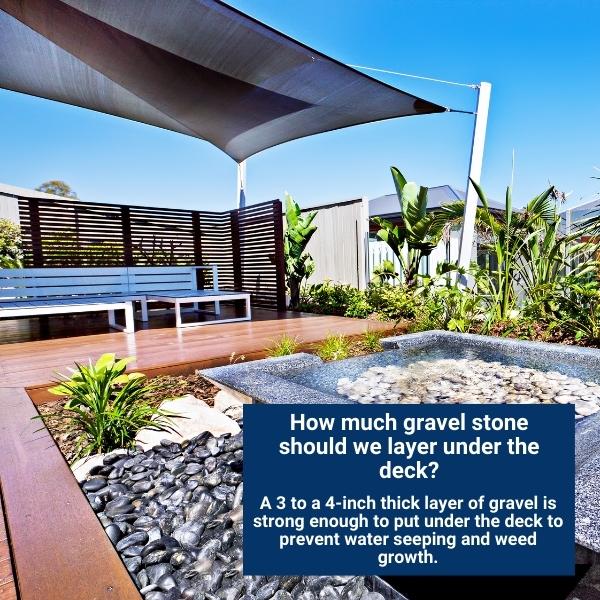A deck is an excellent method to expand your outside area and provide a level platform for sitting and relaxing. However, maintaining its stability and increasing its life span starts with solidifying its base or the platform beneath it. However, you might wonder what is the best material to place under the deck.
Gravel is the perfect material to put under the base of your deck. Though you can layer the bottom with mulch, grain sand, rocks, limestone, soil, or plastic, the best material is the one that can protect your hardwood from weed or moss growth, allow rainwater to pass, and keep water away from the hardwood.
Each type of material has different characteristics and different pros and cons. The best material should prevent the foundation from deteriorating and the hardwood from destroying from the inside. Therefore we must pick the suitable material to put under our deck. So, if you want to know which material is best, keep reading.
Which Is The Best Material For Layering Under The Deck:
Decks that let rainwater leak between the planks can gather moisture, causing the wood to decay. You can use different materials for under-deck layering. However, you must consider the moisture quantity first before deciding.
Though gravel is the most usual material most companies recommend to put under the deck, there are more options. Concrete pads, red bricks, and pavers are costly materials to layer under the deck. At the same time, the economical possibilities are gravel, soil, mud, mulch, or plastic. Besides, each material has its pros and cons. Below is the material you can layer under your deck and why they are best.
Sand:
Sand is a decent material for under-deck layering on the ground. It undoubtedly has more significant drainage than soil, Yet it is not as effective as stones in this regard. The compacted Sand allows water to flow slowly and consistently. It means the water will not puddle and flow slowly, leaving little moisture behind. Therefore, it’s not suitable for locations with high rainfall where rapid drainage is necessary.

The sand texture and refined grains make it simple to create by hand. Moreover, it has outstanding strength too. Sand compacts with time. You need to fill the holes constantly and keep leveling them off. Besides, it soaks water and decays readily. It also allows insects, rodents, and plants to grow without much hindrance because the soil has all the organic properties helpful for plant growth and insect habitat.
Lime Stone Or Soil:
Limestone or soil is another alternative for the ground underneath your hardwood deck. Since limestone is a fine powder, it is the simplest to compact and level. However, because it does not stop weed growth, using it may become less appealing. Besides, exposed soil may pick up rainwater or harden and become erosive. In addition to enjoying the shelter, animals and plants utilize it as a place to nest, bread, excrete waste or a place to dig.
Also Read: Is Cabot A Good Deck Stain? A Detailed Guide!
Mulch:
Placing the appropriate mulch beneath your decking is one of the most effective methods to keep weeds at bay. Wood shavings, sawdust, or organic mulch underneath a deck in a dry area can work well. However, insects, reptiles, and rats may also like it. You can also layer mulch beneath your deck to prevent soil erosion and promote good water runoff. It means fewer weeds, fewer critters creating nests in this area, and very few insects reproducing beneath your deck.

On the contrary, in wet and humid areas, avoid utilizing pine needles, bark mulch, straw, nutshell or leaves as mulch beneath a deck. These natural materials will absorb water beneath your deck. Likewise, rainy or wet climes and shaded conditions make it challenging for mulch to dry out quickly. It may cause fungal development and decay, harming your deck pillars, wood, and house base.
Plastic:
Plastic and landscaping fabric is used alone or in conjunction with another type of ground layering material. Both materials reduce erosion, limit moisture accumulation, and keep pests and weeds at bay. Unfortunately, they appear and perform more effectively when held in place by another substance. Yet, using a weed barrier and plastic doesn’t limit the possible drawbacks of under-deck layering materials like sand, mulch or soil. Landscape fabric is more durable than plastic since plastic becomes brittle if exposed to environmental cracks. But, Plastic may endure for years if placed under mulch or stones.
Moreover, in areas with frequent rain and snow, water puddles over plastic can multiply the insect growth and lousy smell around your deck. Since plastic is a substantial barrier to water, it no doubt will stop the water from seeping through. Yet it will collect water itself and cause problems.
Gravel:
A bed of crushed gravel is the finest option for use beneath a deck. It doesn’t matter if you use plastic or weed barrier with gravel. It will stand durable for years even without them. Since gravel dissipates moisture rather than absorbing it, they keep the area beneath the deck dry and prevent rotting. Besides, it will provide the finest drainage, allowing rapid runoff without water flooding. These granules are bigger than other alternatives. Therefore they have the best load-carrying capacity and structural stability.
While dramatically enhancing the rain and water runoff beneath the decking, it offers numerous additional advantages. It can potentially limit weed growth and sand erosion and is visually appealing. The stone looks esthetic yet isn’t as appealing to creatures or insects. Because gravel keeps the area beneath your deck dry, It also serves as a tidy storage room for yard goods, toys, and sometimes tools. It assures that whatever you put under your deck is not continually resting on wet ground.
Also Read: How To Seal Pressure-Treated Wood:
Type Of Rocks To Use Under Deck?
Though gravel is the best option for under-deck layering and keeping it well-maintained, different rock types are available. You can use expensive rocks to provide an elite, aesthetic layer under your deck with premium durability. Or you can pick the least expensive crushed rock that is durable and cheap at once. Your area, stone visibility, and budget can help you decide on the variety of gravel to put under the deck. There are several hues to choose from, some foreign and expensive and others homegrown yet beautiful.

Crushed Stones:
Though several varieties of crushed gravel are present, the ideal gravel size is between (3/4) 0.75 inch and 1 inch. It is crucial to mention whether the gravel is clean or washed. Dust, soil, and dirt can accumulate and stop water from permeating to and from the deck. To avoid organic material building up and resulting in damage, you must clean organic debris from crushed gravel with rough edges that might capture leaves and other rubbish.
River Rock:
River rock typically has sleek, rounded facets and ranges in diameter from half an inch to eight inches, but bigger sizes can be obtained. The rounded edges might make it simpler to walk or crawl over. They are less prone to snag trash due to their large size and fine finish. Even though some people chose enormous river rock, the two most popular sizes to put beneath a deck are 1/2 x 7/8 inch and 5/8 x 1 to 1/8 inch diameter.
Also Read: What Happens If You Stain Treated Wood Too Soon?
Pea Gravel:
Pea gravel has smooth edges and is as tiny as a pea. It ranges from 1/8 inch to 3/8 inch, making it easy to grip and providing a smooth walking experience. Additionally, these are not prone to capturing garbage like twigs. Although rain and moisture may seep through pea-sized pebbles, they are enough to stay for a more extended period than more giant stones.
Egg Rock:
Egg rocks are 1 to 2-inch-sized egg-shaped rocks found near rivers and streams. People also call it machine-washed stone. The flat surfaces of the elongated stones make them less prone to gather leaves or other detritus. However, crawling over them is challenging due to their irregular shape. These rocks are perfect if you want an appealing under-deck look.

Conclusion:
To provide a firm platform for the deck, you must ensure the area under your deck is adequately filled and leveled. Whether you use gravel, soil, egg rocks, sand, limestone, mulch, or any other substance, don’t forget to maintain and clean it regularly. Avoid placing organic items under your deck since they could move or deteriorate over time and harm your deck. To keep the building dry, make sure that sufficient drainage is possible.
Also Read: Best Temperature Ranges For Staining Deck
Remember that weeds, water and insects are the enemies of your deck health. So always consider your environment and possibilities that may appear in your house condition before placing anything under your deck. However, if you have no idea about water drainage, gravel is the best material to put under the dock. At the same time, crushed gravel is the gravel type you should preferably put under your deck because it’s perfect in all aspects.

